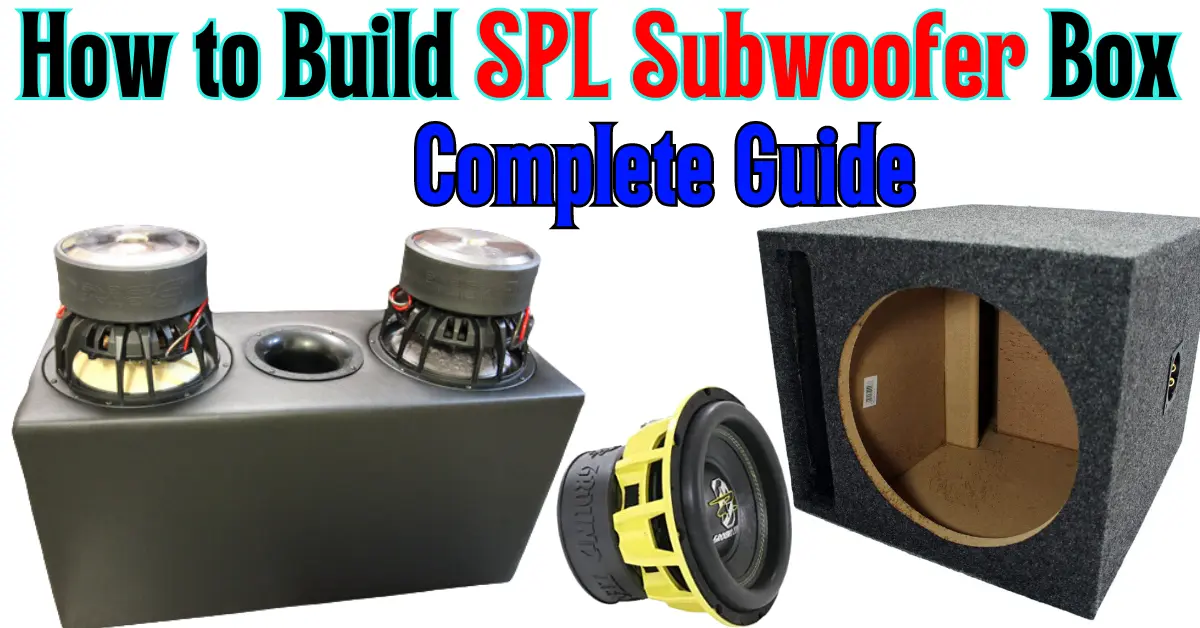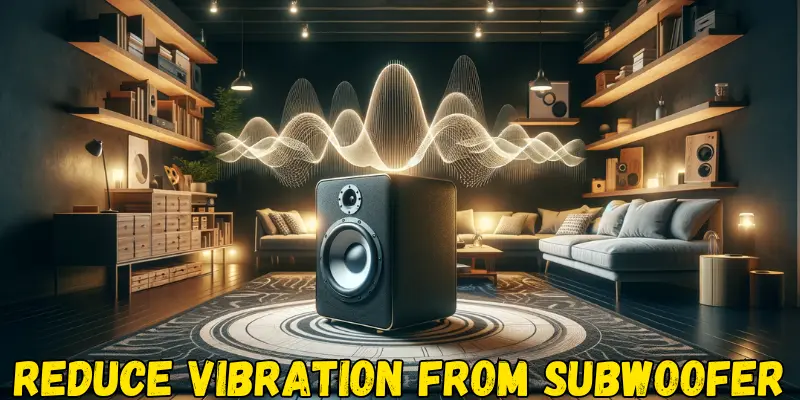
Which Materials You Will Need to Build Subwoofer Box?

To build the loudest subwoofer box design, you first need the materials.
It would be best to build the box’s wall with fiberboard or birch plywood. Both these materials are robust, easy to work with, and give good results. You should avoid materials like chipboard and particle board.
For the inside of the box, you need some sound-dampening material to absorb the sound waves. You can use materials such as polyfill, fiberglass, or foam for this task. Polyfill will be best for this work.
How to Build a Subwoofer Box?
Now you know the material, let’s learn how to build a subwoofer box.
Determine the Optimal Box Size

After gathering the materials to build a subwoofer box, you need to measure your box size to determine how big a box you want to make.
The size of the box also plays an important role. Measure the box size based on how much sound and bass you want for your music.
You must use a subwoofer box calculator to determine the optimal box size. These tools allow you to enter your subwoofer’s specifications, such as the size, power handling, and desired frequency response, and calculate the ideal box size.
Design the Enclosure

Before building a subwoofer box, you have to design the wall of the box. You can consider the box’s size, shape, and placement of the subwoofer to create the box’s design.
There are two basic types of subwoofer boxes: Sealed and Ported.
- Sealed boxes: Sealed boxes are the most straightforward design and generally the best sound quality option.
- Ported boxes: Ported boxes, conversely, are more complex and offer more volume and bass output. However, they can be more challenging to design and build.
Cut and Assemble the Box
Once your design is finalized, you can start cutting and assembling the box. Use a table saw or circular saw to cut the MDF or plywood into the appropriate sizes. Then, use wood glue and clamps to hold the pieces together while the glue dries.
Once the glue has dried, you can reinforce the corners with bracing. It’ll help prevent the box from flexing and vibrating. Use screws and wood glue to attach the bracing to the box’s corners.
Installing the Subwoofer Inside the Box:

When your box is complete, you must install the subwoofer inside. Use a jigsaw or router to cut a hole in the box that matches the size of the subwoofer.
Then, screws and a gasket attach the subwoofer to the box. Be sure to seal the edges of the subwoofer with silicone caulk to prevent air leaks.
Add Acoustic Damping Material

We have learned how to build the subwoofer box and install it. Now you have to add acoustic damping material inside the box.
This material absorbs the waves generated inside the box, allowing you to hear the music. You can use polyfill, fiberglass, or foam for this.
Test and Tune the Box
After you’ve adjusted the acoustic cloth inside the box, it’s time to test the box. To try the box, you play music through the subwoofer and adapt the design and placement of the box as needed.
You’ll need a sound pressure level (SPL) meter and a tone generator to test the box. The SPL meter measures the loudness of the sound, while the tone generator produces a specific frequency.
Start by playing a test tone through the subwoofer at a low volume and adjusting the subwoofer’s position until you get the desired response.
Next, gradually increase the volume and test the box’s performance at various frequencies. You may need to adjust the box’s design or placement if you notice any distortion or noise.
This process may take some trial and error, but you can fine-tune your box with patience and persistence for optimal performance.
Read More: What Makes a Subwoofer Loud
How to build a subwoofer box for deep bass?
To build a subwoofer box for deep bass, you can follow the below instructions:
- First, determine what type of box you want to make. You can create two types of boxes: ported or sealed.
- Once your box is selected, you need to design the box according to the size of the subwoofer.
- After making the design, you must cut the plywood according to that design.
- After you have cut the plywood, you have to attach the plywood using glue or nails.
- After connecting the box, you have to install the subwoofer in it.
- After you’ve installed the subwoofer, you’ll need to add acoustic damping material to the box.
- After doing this, your subwoofer box will be ready. Now you have to test your subwoofer box.
Common mistakes to avoid when building a subwoofer box:
Many people make a few mistakes when building a subwoofer box that results in a poor box. Today I’ll also tell you about the mistakes that you should not make.
Choosing the Wrong Box Size
Choosing the right size is one of the most critical factors in building a subwoofer box. A box that’s too small can result in distorted sound, while a box that’s too large can cause the subwoofer to produce weak or muffled bass.
To avoid this mistake, it’s essential to do your research and calculate the optimal box size based on the subwoofer’s specifications and the type of music you plan to listen to.
Poor Box Design
Another common mistake is using poor box design. A well-designed subwoofer box should have a sturdy construction, airtight seals, and optimal port size and placement. Poor box design can lead to unwanted vibrations, distortion, and reduced sound quality.
You’ll only get good results if your box design is good. To make the design of the box good, you should take instructions from someone and use high-level materials.
Incorrect Subwoofer Placement
The subwoofer’s placement within the box is crucial to achieving optimal sound quality. Placing the subwoofer in the wrong position can lead to distortion, reduced bass response, and poor sound quality.
To avoid this mistake, follow the subwoofer’s instructions for placement within the box. Consider the size and shape of the subwoofer and the box’s design when determining the optimal placement.
Poor Acoustic Damping
Acoustic damping materials are essential for reducing unwanted vibrations and noise within the box. Poor acoustic damping can lead to distorted sound and reduced overall sound quality.
To avoid this mistake, be sure to choose high-quality acoustic damping materials and follow the instructions for installation. Consider adding multiple layers of damping material for optimal sound quality.
Incorrect Wiring
The wiring of the subwoofer within the box is another critical factor in achieving optimal sound quality. Incorrect wiring can lead to reduced bass response and distortion.
To avoid this mistake, follow the subwoofer’s wiring instructions carefully. Consider using high-quality wiring and connectors for optimal performance.
Conclusion on How to Build Subwoofer Box
In today’s article, I have given you a complete guide on how to build a subwoofer box. Few points you have to keep in your mind to build a subwoofer box design for deep bass.
- What materials do you need to make the box?
- Measuring the optimal size of the box.
- Box design
- Subwoofer placement
- Adjusting the sound-damping material
Considering all these points, you can quickly build the Subwoofer Box.
If you have any questions about building a subwoofer box, please ask me through the comment section. I’ll answer your every question as soon as possible. If you like it, share this article with your friends so they can build a box for their subwoofer.
FAQs: How to Build Subwoofer Box
What is the best SPL subwoofer box design for deep bass?
The best subwoofer box design for deep bass depends on your specific subwoofer and personal preferences. Ported boxes are typically better for deep bass, allowing more airflow and better bass response. However, sealed boxes can also produce deep bass when designed correctly. Consider using a subwoofer box calculator or designer to help determine the best design for your needs.
Can I build my SPL subwoofer box kit?
Use suitable materials and instructions to build your subwoofer box kit. Many subwoofer manufacturers offer DIY kits with all the necessary materials and instructions to make your box. Alternatively, you can purchase materials and use free subwoofer box design software online to create your custom box.
What is the loudest subwoofer box design?
The loudest subwoofer box design will depend on your specific subwoofer and preferences. Generally, ported boxes are louder than sealed boxes, as they allow for more airflow and better bass response. However, a poorly designed ported box can also lead to distortion and reduced sound quality. Consider consulting a subwoofer box designer or calculator to determine the best design for your needs.
Is there free subwoofer box design software online?
Free subwoofer box design software online can help you design your custom box. Some popular options include WinISD, Torres Box Tuning Calculator, and CarStereo.com’s Subwoofer Box Enclosure Designer. These tools can help you determine the optimal box size, tuning frequency, and other design features for your subwoofer.
What is a subwoofer box calculator?
A subwoofer box calculator is a tool to determine the optimal box size and design for a specific subwoofer. These calculators consider the subwoofer’s specifications, desired tuning frequency, and other factors to help you create the best possible box design. Some popular subwoofer box calculators include WinISD, Torres Box Tuning Calculator, and CarStereo.com’s Subwoofer Box Enclosure Designer.






